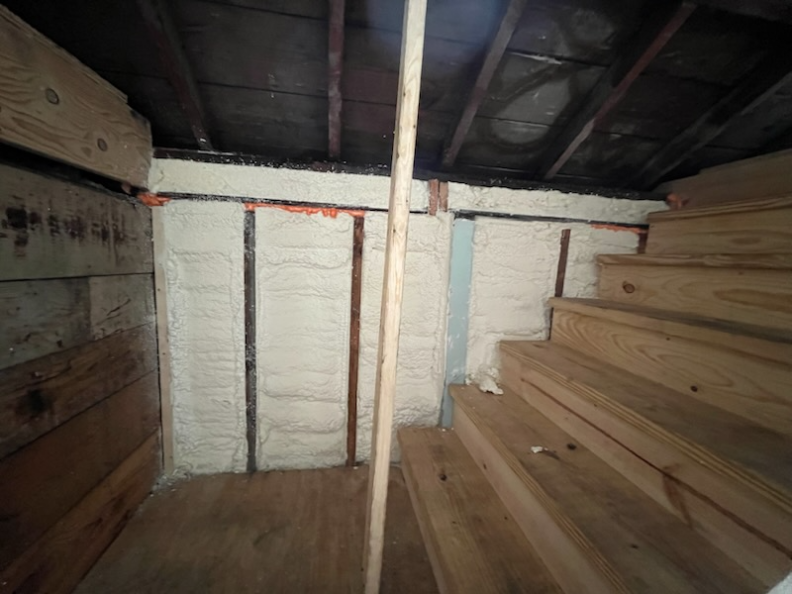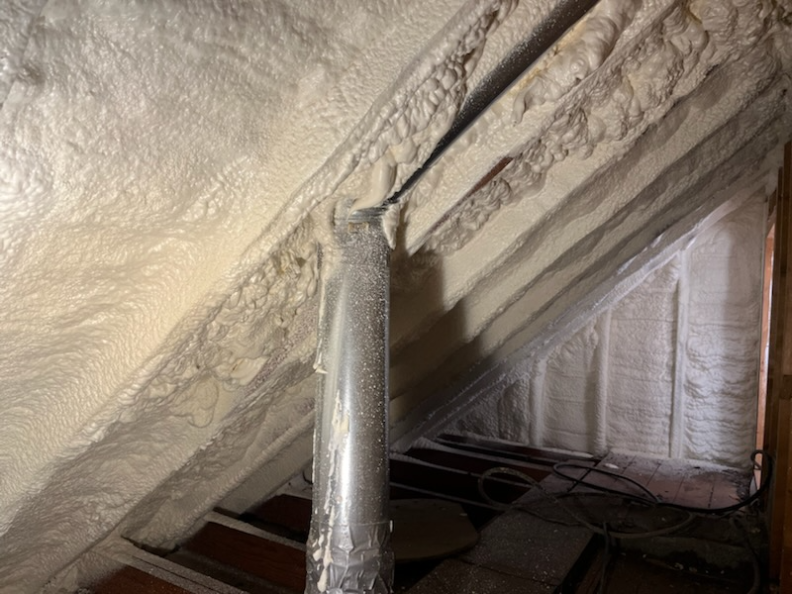
Spray foam insulation seals surfaces tightly, but applying it over a damp area locks in moisture and creates serious problems. Water trapped behind the foam promotes mold growth, weakens building materials, and reduces the insulation’s effectiveness. Homeowners often face costly repairs when this happens, as the foam hides the issue until damage spreads.
This article breaks down the reasons behind this advice and offers practical steps to avoid trouble. Years of handling insulation jobs in the Chicago area, where humidity and temperature swings make moisture control tricky, back up these points. South Chicago Insulation draws from real projects to share what works and what fails.
One of the most immediate dangers here is mold growth and the health risks it brings. When spray foam covers a wet surface, it forms an airtight barrier. That keeps evaporation from occurring normally. Instead, the dampness stays put, creating ideal conditions for mold to thrive. Mold spores need only a bit of water and warmth to multiply fast.
In one case, a basement wall with minor leaks got sprayed over. Within months, black mold appeared inside the walls. Removing the foam to fix it cost thousands. Health effects hit residents too—coughs, allergies, and worse for those sensitive to spores.
Data from the Centers for Disease Control and Prevention (CDC) indicates that about 20% of U.S. homes deal with dampness issues, and unchecked moisture raises asthma risks by up to 40% in children. Chicago’s wet springs add to this, as basements often stay humid.
Bonus Tip: Before any insulation, run a moisture meter over surfaces. Levels above 15% signal a need to dry out first.
Trapped water doesn’t just breed mold; it rots wood and corrodes metal over time. Spray foam sticks firmly, so early signs of trouble stay out of sight. Floors soften, walls buckle, and foundations crack as materials absorb ongoing moisture.
Contractors see this often in older homes. A rim joist sprayed while damp led to sagging floors after two years. The repair involved tearing out the foam and replacing joists. This kind of damage shortens a building’s life and invites pests like termites drawn to wet wood.
The U.S. Department of Energy warns that improper installation, including over moist areas, cuts insulation performance by 50% or more. In the Midwest, freeze-thaw cycles worsen this—water expands when it freezes, pushing against sealed barriers.
Spray foam relies on dry contact for proper curing and adhesion. Dampness interferes, leaving gaps or soft spots that let heat escape. Energy bills rise as the system fails to hold warmth in winter or cool air in summer.
Tests show that foam on wet surfaces expands unevenly, creating voids. Air leaks through these, making the whole setup inefficient. In Chicago’s climate, where winters dip below freezing and summers turn muggy, this inefficiency hits hard on utility costs.
A study by the Building Science Corporation shows how moisture beneath foam leads to condensation buildup. That further degrades the material, sometimes causing it to shrink or delaminate.
To illustrate these differences, the table below compares various insulation types and their suitability for damp surfaces:
| Insulation Type | Suitability on Damp Surfaces | Key Risks | Effectiveness Rating (Dry vs. Damp) |
|---|---|---|---|
| Spray Foam | Poor | Mold, rot, voids | 90% vs. 40% |
| Fiberglass Batt | Fair, with drying | Settling, reduced R-value | 80% vs. 60% |
| Rigid Foam Board | Good, if ventilated | Less sealing | 85% vs. 70% |
| Cellulose | Excellent, absorbs moisture | None if dried | 85% vs. 80% |
Rigid boards and cellulose handle minor dampness better by allowing some drying.
Bonus Tip: Pair insulation with vapor barriers only on walls facing conditioned space. In basements, permeable materials prevent trapped humidity.

Assess surface dryness first—use fans, dehumidifiers, or heaters to bring moisture down. Check for ongoing leaks from roofs, pipes, or grading issues outside. Budget for fixes before insulation to avoid double work later.
Think about the building’s age and local weather. Older Chicago homes with poor drainage face higher risks. Weigh long-term costs: cheap shortcuts now mean expensive overhauls soon. Consult local codes, which often require dry substrates for foam.
Evaluate alternatives like drying the area fully or switching to breathable insulations. Factor in energy goals—proper installation saves more over time than quick fixes. Health and safety come first, especially for families.
Foam bonds strongly to surfaces, which makes it appealing as a fast fix. However, this strength can hide underlying dampness, allowing bigger problems to develop unnoticed.
Visual checks rarely catch every issue. Professionals use infrared cameras and other diagnostic tools to accurately identify concealed wet areas before sealing.
No. Even partial applications can be risky, since moisture migrates behind walls. Spot spraying often masks the issue rather than solving it.
Bonus Tip: Schedule inspections during dry seasons. Chicago’s fall offers stable conditions to test without rain interference.
Market facts reinforce this: The Insurance Information Institute reports water damage claims topped $10 billion in 2022, with mold often the culprit in insured homes.
Even small damp spots spread moisture under the seal. Mold starts there and invades wider areas, leading to bigger repairs. Dry everything thoroughly instead.
No, the foam blocks airflow, so the dehumidifier can’t reach trapped water. Address dampness before application to prevent this.
Test with a pin-type meter; readings over 12-15% mean wait longer. In humid Chicago, surfaces take days to dry fully.
Yes, isolate dry sections and use separate barriers. But pros recommend full drying for the whole job to avoid migration.
Cut it out immediately and inspect for damage. Call experts for remediation to stop mold spread and restore the surface.
Avoid spray foam on damp surfaces to prevent mold, damage, and inefficiency. Dry areas first, choose breathable options, and follow local climate rules. Evaluate your home’s setup carefully for lasting results.
Readers should inspect their properties now, fix leaks, and plan insulation with moisture in mind. Match choices to specific needs and goals for better comfort and savings.
For questions on handling damp surfaces or picking the right insulation, reach out to South Chicago Insulation at [email protected] or call (779) 803-8025. Experts review sites and suggest steps based on real conditions. This ensures projects stay on track without hidden issues. (78 words)